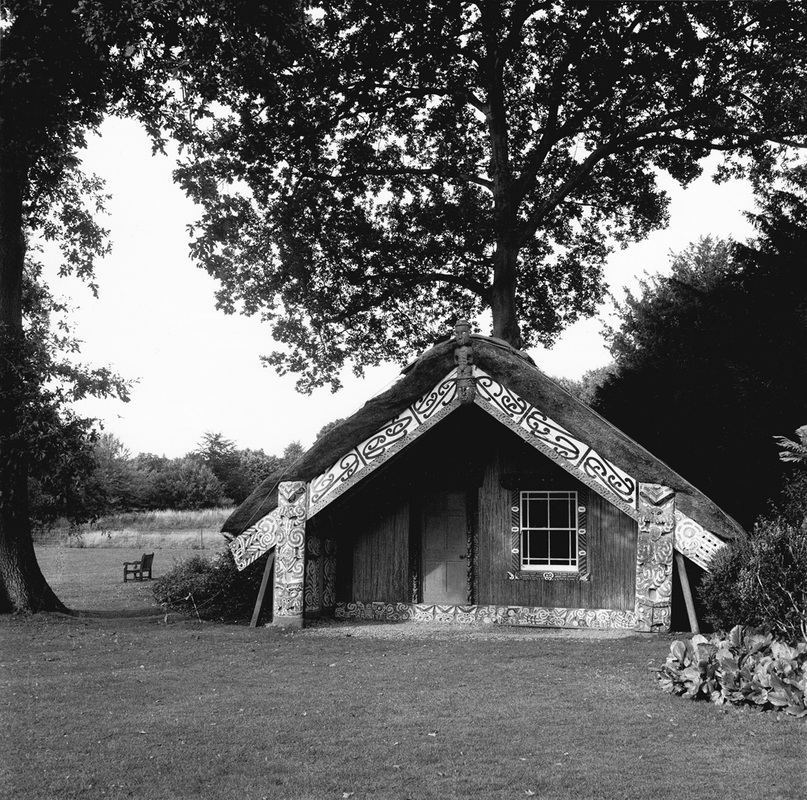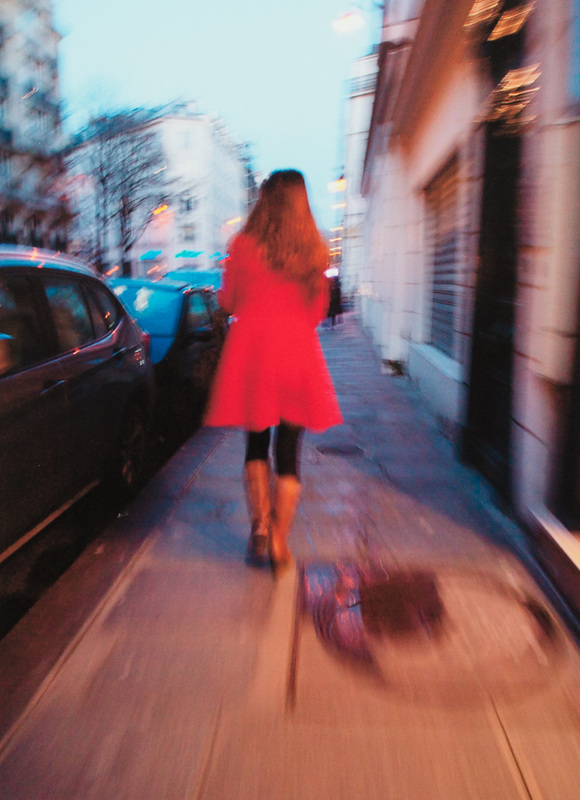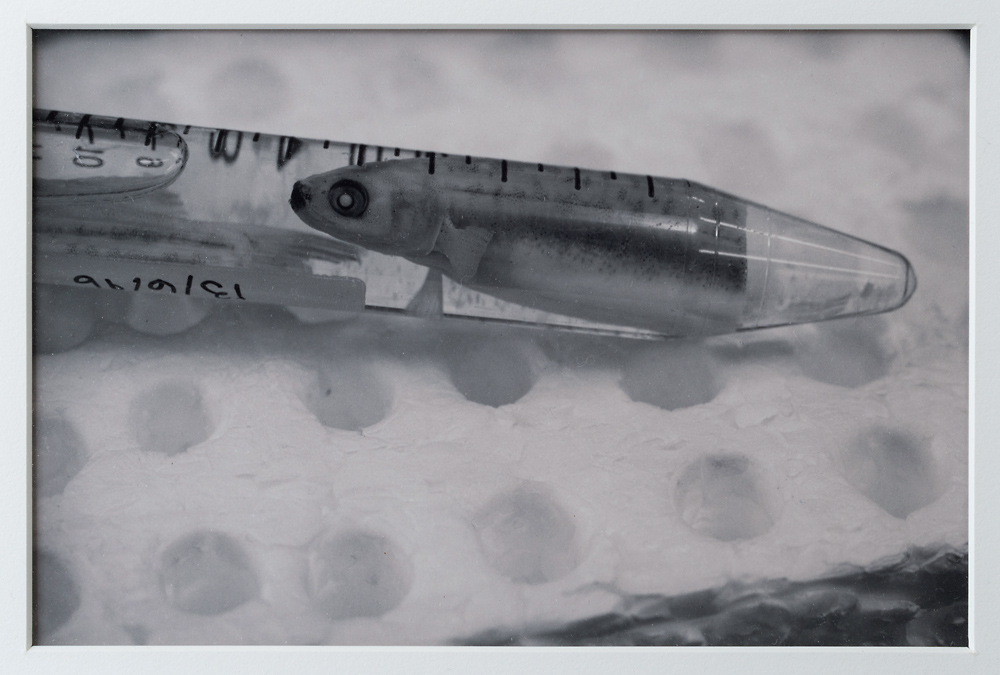Andrew Ross - a UK whare This photograph is from a series of 'travel photos' taken in England in 2008 by Andrew Ross, using a medium format Rolleicord camera (2 1/4" inches square, not his usual 8"x10") for its portability. It is not the only photo of this whare, (Maori house) by a major New Zealand photographer, but it is possibly the most charming. (Mark Adam's magnificent photo diptych 13.11.2000, Hinemihi, Clandon Park, Surrey, 2000 is illustrated on pages 18-19 of Pictures They Want to Make - see my review in this blog. The Adams prints are in colour, and large scale, whereas Andrew Ross's was printed about eight inches square, a silver-gelatine darkroom print. It was exhibited at Photospace in September, 2009. See Andrew Ross - England Photographs for more images from this series.)
The England photos managed to meet the tough Photospace Gallery criteria for travel photographs: If your photographs fall into the general categories of Travel, Scenic Landscape, or Close-ups of Nature, they will have to be extraordinarily good to merit an exhibition! (And it is perhaps worth mentioning that similar sets of photographs taken in the US and Canada by the same photographer did not meet the criteria.) The photos, taken squarely (pardon the photographic pun) in this century, look like something out of a bygone era - actually, but not strangely, like most of Andrew Ross's photographs. The rural landscapes, in particular, look like scenes Beatrix Potter would have drawn inspiration from. He has an eye for the past existing in the present, for sure; but in these England photos the scenery and buildings would seem to have a stable enough future. By contrast, his photos taken in New Zealand capture the more fragile and less protected history of this much younger country. The wrecking ball is too often swinging in from just outside the frame. I won't repeat the extraordinary story behind this Maori building coming to be in Surrey, as its history can be found here on the National Trust site, in this Wikipedia article, and elsewhere.
0 Comments
Colour, and more OK, with all the excitement around the America's Cup sailing, etc, I forgot to do a post yesterday. This column has not yet become habitual. But enough excuses already.
Brett Stanley's folio of photographs has been around the office now for a fortnight, following an interesting discussion with him about some aspects of photography - but that's something for another day. This photo attracted me by its pure focus on colour. (The folio contains mostly black & white photos in the Formalist tradition, but the previous two Friday Photos have been of that type, so time for a change.) The photo was taken in the evening, using a slowish shutter speed, which has the effect of adding blur caused by the movement of the camera (mostly) and the subject. This is not a fault, but a factor that adds something good to the photo. The colour balance is also on the warm side, due to the street lighting. Overall, the balance and distribution of colours and tones in the composition is very pleasing, making a photo with perhaps a celebratory tone. It beautifully captures the mood of a walk home on a cool evening. I took a similar photo myself recently, but Brett's one is better. Now, the difficult bit. I remember what went through my head when I took my photo of a woman in a red coat, from behind. On one level, I was out photographing, looking to collect 'good' images. On the other, there is an uncomfortable feeling of being in the act of stalking, and of taking something from (of?) somebody without their knowledge. Collecting them. Anyone who has done any of what is known as Street Photography will know this feeling. It is slightly different when photographing someone of the same sex (if you're heterosexual) but the act is similar even when the sexual overtone is absent. Susan Sontag had quite a bit to say about this in her seminal book 'On Photography' (Penguin Books, 1977): Between photographer and subject, there has to be distance.The camera doesn't rape, or even possess, though it may presume, intrude, trespass, distort, exploit, and, at the farthest reach of the metaphor, assassinate - all activities that, unlike the sexual push and shove, can be conducted at a distance, and with some detachment. - 'In Plato's Cave' - essay first published in 1973/4. But what is the harm? In this case, the person is not identifiable; and even if she were (say she was walking towards the camera rather than away from it), she is not being defamed in any way. There is no damage done, no personal harm to the photographed. And legally there is no problem. The person in the photograph is out in public, and so as long as their image is not exploited by commercial interests (for example, it is used without consent in an advertising campaign) or there is some aspect of defamation (the person is picking their nose, perhaps) there is no legal case. Or is there? Times, they are a changing. I had an interesting confrontation the other week. I was out photographing with someone and was showing them how to take a 'panning' photograph in the low light. A cyclist approached out of the dusk, visible as the Blackpool Illuminations. Bingo! I panned with his movement and shot at 1/8 of a second. The photographic result wasn't great but it served to illustrate the point. Half a minute later, he cycled up to me and asked, 'What was that all about?' He had thought enough about being photographed to turn 180 degrees from his destination. I showed him the photo I'd taken, which depicted an unrecognisable human riding a bicycle, amidst much other blur. 'I do not give you permission to publish that photograph. It infringes my personal privacy.' 'Hang on a minute. You're not even recognisable, and you're out in public so you have no personal privacy.' This conversation (I called it a confrontation earlier) was conducted in a polite and friendly tone on both sides. The cyclist repeated his request that I not publish the photograph. He also countered my view on public space and personal privacy by saying that internationally, laws are changing, and that I should be careful what I do in future. Once he was satisfied that I had no intention of publishing the photo and that he'd got his point across, we parted ways. It took me a while to process what he said, as I was pretty sure I was in the right - that he had no right of privacy in the public space of a street. What about all the books of street photography published in New Zealand and internationally - even quite recently - that show people, many 100% identifiable, going about their private business in public? None of those people gave their permission to have their images used in books and photography exhibitions. And in many cases, the books are being sold by legit publishers, and photographs are being sold in galleries, all of which involves money changing hands. (Whether it's profitable or not is a moot point, but the usual intent is to make some profit from it.) The cyclist was correct; there has been a trend, internationally, for law changes to protect the privacy of individuals while they are in public places. This can mean no photographs without written consent. It seems ironic that France has led this trend, being the home of Henri Cartier Bresson, et al - really the birthplace of street photography. So all this leaves us in a rather uncomfortable position in regard to the future of street photography. What will unfold? I don't wish to finish this post on a down note (maybe today's yacht racing has affected things), so I would like to say that I enjoy street photography - looking at it, doing it myself, and exhibiting others' work in Photospace Gallery. I have used Brett Stanley's photograph to discuss some of the less savoury and more concerning aspects of street photography, but it is not my intention to demean him or his work. I chose this photo because I really quite like it - its celebration of someone's decision to wear such colour and brighten up the world - and I wish to be able to keep on viewing and exhibiting its like and other street photography in future without the interference of well-meaning but ultimately wrong-thinking busybodies. Added 11th Nov 2013: Further reading: On Documentary Ethics, by Greg Halpern (Thanks Peter Black, for the link.)
|
AuthorPhotography Matters II Categories |




 RSS Feed
RSS Feed
